Applying User-Perceived Value to Determine Motivators of Electricity Use in a Solar Photovoltaic Implementation in a Philippine Island
Abstract
:1. Introduction
2. Understanding the Drivers of Electricity Consumption in Rural Areas
3. Materials and Methods
3.1. Conceptual Framework
3.2. Case Environment
3.3. Data Collection and Treatment
4. Results and Discussion
4.1. What Motivates Rural Households to Consume Electricity?
4.2. Household Income and Educational Attainment as Influencers to Motivate Electricity Consumption
5. Potential Impacts to Rural Island Electrification in the Philippines
6. Conclusions
Author Contributions
Funding
Institutional Review Board Statement
Informed Consent Statement
Data Availability Statement
Acknowledgments
Conflicts of Interest
Appendix A
| Motivator | Consumer Value | Statements Degree of Motivation to Consume | |
|---|---|---|---|
| M1 | Confidence in system reliability | Functional value | I am motivated to consume electricity because I am confident that the solar PV system is reliable and will not break down despite using various electrical appliances. |
| M2 | Confidence in adequacy of supply | Functional value | I am motivated to consume electricity because I am confident that the system supply is enough to provide for the requirements in powering up the electrical appliances that I wish to use. |
| M3 | Increased access to information | Social value | I am motivated to consume electricity because it has provided my household increased access to information and knowledge attainment through television, internet, and other media. |
| M4 | Increased access to conveniences | Social value | I am motivated to consume electricity because it has provided my household with increased access to conveniences such as electric fans and rice cookers. |
| M5 | Better status in the local community | Social value | I am motivated to consume electricity because having increased access has conveyed better status for my household in relation to our neighbours. |
| M6 | Local organization and sense of ownership | Social value | I am motivated to consume electricity because my household is part of an organization that manages the solar PV system, and it has provided me with a sense of ownership of the system. |
| M7 | Satisfying curiosity of renewable energy | Epistemic value | I am motivated to consume electricity because I want to satisfy my curiosity with regards to renewable energy technologies as electricity sources. |
| M8 | Satisfying prior knowledge of renewable energy | Epistemic value | I am motivated to consume electricity because I want to satisfy my prior knowledge of renewable energy technologies. |
| M9 | Transparency of the system | Emotional value | I am motivated to consume electricity because I am able to determine and control our consumption through electrical meters installed in my household. |
| M10 | Assurance in health and well-being | Emotional value | I am motivated to consume electricity because this has assured the health and safety of my household members. |
| M11 | Equitability of tariff | Economic value | I am motivated to consume electricity because the tariff is more equitable now that we have increased access as compared to before. |
| M12 | Ability to engage in productive uses of electricity (PUE) | Economic value | I am motivated to consume electricity because this has allowed my household to use appliances and tools that can improve our income-generating activities. |
References
- The World Bank. Tracking SDG7: The Energy Progress Report 2019; Access to electricity; The World Bank: Washington, DC, USA, 2019; pp. 1–26. [Google Scholar]
- United Nations Department of Economic and Social Affairs. SDG 7-Progress and Info 2020; United Nations: New York, NY, USA, 2020. [Google Scholar]
- International Energy Agency. Energy Access Outlook; International Energy Agency: Paris, France, 2017. [Google Scholar]
- Sapkota, A.; Lu, Z.; Yang, H.; Wang, J. Role of renewable energy technologies in rural communities’ adaptation to climate change in Nepal. Renew. Energy 2014, 68, 793–800. [Google Scholar] [CrossRef]
- Rahman, M.M.; Paatero, J.V.; Lahdelma, R. Evaluation of choices for sustainable rural electrification in developing countries: A multicriteria approach. Energy Policy 2013, 59, 589–599. [Google Scholar] [CrossRef] [Green Version]
- Müller, M.F.; Thompson, S.E.; Kelly, M.N. Bridging the information gap: A webGIS tool for rural electrification in data-scarce regions. Appl. Energy 2016, 171, 277–286. [Google Scholar] [CrossRef] [Green Version]
- Odou, O.D.T.; Bhandari, R.; Adamou, R. Hybrid off-grid renewable power system for sustainable rural electrification in Benin. Renew. Energy 2020, 145, 1266–1279. [Google Scholar] [CrossRef]
- Boulmrharj, S.; NaitMalek, Y.; Elmouatamid, A.; Bakhouya, M.; Ouladsine, R.; Zine-Dine, K.; Khaidar, M.; Abid, R. Approach for dimensioning stand-alone photovoltaic systems. Energy Procedia 2018, 153, 56–61. [Google Scholar] [CrossRef]
- Gaur, A.S.; Das, P.; Jain, A.; Bhakar, R.; Mathur, J. Long-term energy system planning considering short-term operational constraints. Energy Strateg. Rev. 2019, 26, 100383. [Google Scholar] [CrossRef]
- Mainali, B.; Silveira, S. Alternative pathways for providing access to electricity in developing countries. Renew. Energy 2013, 57, 299–310. [Google Scholar] [CrossRef]
- Müller, M.F.; Thompson, S.E.; Gadgil, A.J. Estimating the price (in)elasticity of off-grid electricity demand. Dev. Eng. 2017, 3, 12–22. [Google Scholar] [CrossRef]
- Blodgett, C.; Dauenhauer, P.; Louie, H.; Kickham, L. Accuracy of energy-use surveys in predicting rural mini-grid user consumption. Energy Sustain. Dev. 2017, 41, 88–105. [Google Scholar] [CrossRef] [Green Version]
- Mahapatra, S.; Dasappa, S. Rural electrification: Optimising the choice between decentralised renewable energy sources and grid extension. Energy Sustain. Dev. 2012, 16, 146–154. [Google Scholar] [CrossRef]
- Sato, T.; Ide, J.; Isa, M.A.; Rahadian, F.; Tokihiko, F.; Yukihiro, S. A Challenge for Sustainable Electrification, Respecting the Local Tradition in Ciptagelar Village, West Java, Indonesia: Complementary Approach with a Private Company. Energy Procedia 2017, 141, 4–8. [Google Scholar] [CrossRef]
- Leary, J.; Schaube, P.; Clementi, L. Rural electrification with household wind systems in remote high wind regions. Energy Sustain. Dev. 2019, 52, 154–175. [Google Scholar] [CrossRef]
- Eras-Almeida, A.A.; Fernández, M.; Eisman, J.; Martín, J.G.; Caamaño, E.; Egido-Aguilera, M.A. Lessons learned from rural electrification experiences with third generation solar home systems in latin America: Case studies in Peru, Mexico, and Bolivia. Sustainability 2019, 11, 7139. [Google Scholar] [CrossRef] [Green Version]
- Barnes, D.F. Effective solutions for rural electrification in developing countries: Lessons from successful programs. Curr. Opin. Environ. Sustain. 2011, 3, 260–264. [Google Scholar] [CrossRef]
- Palit, D.; Bandyopadhyay, K.R. Rural electricity access in South Asia: Is grid extension the remedy? A critical review. Renew. Sustain. Energy Rev. 2016, 60, 1505–1515. [Google Scholar] [CrossRef]
- Pigaht, M.; van der Plas, R.J. Innovative private micro-hydro power development in Rwanda. Energy Policy 2009, 37, 4753–4760. [Google Scholar] [CrossRef]
- Diemuodeke, E.O.; Briggs, T.A. Policy pathways for renewable and sustainable energy utilisation in rural coastline communities in the Niger Delta zone of Nigeria. Energy Rep. 2018, 4, 638–644. [Google Scholar] [CrossRef]
- Rolland, S. Switched on to mini grids. Renew. Energy Focus 2011, 12, 10–12. [Google Scholar] [CrossRef]
- Chaurey, A.; Ranganathan, M.; Mohanty, P. Electricity access for geographically disadvantaged rural communities-technology and policy insights. Energy Policy 2004, 32, 1693–1705. [Google Scholar] [CrossRef]
- Adusah-Poku, F.; Takeuchi, K. Determinants and welfare impacts of rural electrification in Ghana. Energy Sustain. Dev. 2019, 52, 52–62. [Google Scholar] [CrossRef]
- Costello, K.W. Electrification: The nexus between consumer behavior and public policy. Electr. J. 2018, 31, 1–7. [Google Scholar] [CrossRef]
- Ilskog, E. Indicators for assessment of rural electrification—An approach for the comparison of apples and pears. Energy Policy 2008, 36, 2665–2673. [Google Scholar] [CrossRef]
- Ilskog, E.; Kjellstrom, B. And then they lived sustainably ever after?—Assessment of rural electrification cases by means of indicators. Energy Policy 2008, 36, 2674–2684. [Google Scholar] [CrossRef]
- López-González, A.; Ferrer-Martí, L.; Domenech, B. Sustainable rural electrification planning in developing countries: A proposal for electrification of isolated communities of Venezuela. Energy Policy 2019, 129, 327–338. [Google Scholar] [CrossRef]
- Mainali, B.; Pachauri, S.; Rao, N.D.; Silveira, S. Assessing rural energy sustainability in developing countries. Energy Sustain. Dev. 2014, 19, 15–28. [Google Scholar] [CrossRef]
- Mainali, B.; Silveira, S. Using a sustainability index to assess energy technologies for rural electrification. Renew. Sustain. Energy Rev. 2015, 41, 1351–1365. [Google Scholar] [CrossRef]
- Hirmer, S.; Guthrie, P. Identifying the needs of communities in rural Uganda: A method for determining the ‘User-Perceived Value’ of rural electrification initiatives. Renew. Sustain. Energy Rev. 2016, 66, 476–486. [Google Scholar] [CrossRef] [Green Version]
- Tesfamichael, M.; Bastille, C.; Leach, M. Eager to connect, cautious to consume: An integrated view of the drivers and motivations for electricity consumption among rural households in Kenya. Energy Res. Soc. Sci. 2020, 63, 101394. [Google Scholar] [CrossRef]
- González, A.M.; Sandoval, H.; Acosta, P.; Henao, F. On the acceptance and sustainability of renewable energy projects-a systems thinking perspective. Sustainability 2016, 8, 1171. [Google Scholar] [CrossRef] [Green Version]
- Hirmer, S.; Cruickshank, H. The user-value of rural electrification: An analysis and adoption of existing models and theories. Renew. Sustain. Energy Rev. 2014, 34, 145–154. [Google Scholar] [CrossRef] [Green Version]
- Rogers, E.M. Diffusion of Innovations, 4th ed.; Simon and Schuster: New York, NY, USA, 2010. [Google Scholar]
- Graber, S.; Narayanan, T.; Alfaro, J.; Palit, D. Solar microgrids in rural India: Consumers’ willingness to pay for attributes of electricity. Energy Sustain. Dev. 2018, 42, 32–43. [Google Scholar] [CrossRef]
- Müggenburg, H.; Tillmans, A.; Schweizer-Ries, P.; Raabe, T.; Adelmann, P. Social acceptance of PicoPV systems as a means of rural electrification—A socio-technical case study in Ethiopia. Energy Sustain. Dev. 2012, 16, 90–97. [Google Scholar] [CrossRef]
- Shakya, B.; Bruce, A.; MacGill, I. Survey based characterisation of energy services for improved design and operation of standalone microgrids. Renew. Sustain. Energy Rev. 2019, 101, 493–503. [Google Scholar] [CrossRef]
- Lopez-Gonazels, A.; Ranaboldo, M.; Domenech, B.; Ferrer-Marti, L. Evaluation of small wind turbines for rural electrification: Case studies from extreme climatic conditions in Venezuela. Energy 2020, 209, 118450. [Google Scholar] [CrossRef]
- Yadav, P.; Davies, P.J.; Palit, D. Distributed solar photovoltaics landscape in Uttar Pradesh, India: Lessons for transition to decentralised rural electrification. Energy Strateg. Rev. 2019, 26, 100392. [Google Scholar] [CrossRef]
- Aklin, M.; Cheng, C.Y.; Urpelainen, J. Social acceptance of new energy technology in developing countries: A framing experiment in rural India. Energy Policy 2018, 113, 466–477. [Google Scholar] [CrossRef]
- Opiyo, N.N. Impacts of neighbourhood influence on social acceptance of small solar home systems in rural western Kenya. Energy Res. Soc. Sci. 2019, 52, 91–98. [Google Scholar] [CrossRef]
- Heras-Saizarbitoria, I.; Zamanillo, I.; Laskurain, I. Social acceptance of ocean wave energy: A case study of an OWC shoreline plant. Renew. Sustain. Energy Rev. 2013, 27, 515–524. [Google Scholar] [CrossRef]
- Shyu, C.W. End-users’ experiences with electricity supply from stand-alone mini-grid solar PV power stations in rural areas of western China. Energy Sustain. Dev. 2013, 17, 391–400. [Google Scholar] [CrossRef]
- Soltani, M.; Rahmani, O.; Pour, A.B.; Ghaderpour, Y.; Ngah, I.; Misnan, S.H. Determinants of variation in household energy choice and consumption: Case from Mahabad City, Iran. Sustainability 2019, 11, 4775. [Google Scholar] [CrossRef] [Green Version]
- Räty, R.; Carlsson-kanyama, A. Comparing Energy Use by Gender, Age and Income in some European Countries; FOI, Swedish Defence Research Agency: Stockholm, Sweden, 2009. [Google Scholar]
- Shen, M.; Sun, H.; Lu, Y. Household electricity consumption prediction under multiple behavioural intervention strategies using support vector regression. Energy Procedia 2017, 142, 2734–2739. [Google Scholar] [CrossRef]
- Kostakis, I. Socio-demographic determinants of household electricity consumption: Evidence from Greece using quantile regression analysis. Curr. Res. Environ. Sustain. 2020, 1, 23–30. [Google Scholar] [CrossRef]
- Sharma, A.; Agrawal, S.; Urpelainen, J. The adoption and use of solar mini-grids in grid-electrified Indian villages. Energy Sustain. Dev. 2020, 55, 139–150. [Google Scholar] [CrossRef]
- Cuesta, M.A.; Castillo-Calzadilla, T.; Borges, C.E. A critical analysis on hybrid renewable energy modeling tools: An emerging opportunity to include social indicators to optimise systems in small communities. Renew. Sustain. Energy Rev. 2020, 122, 109691. [Google Scholar] [CrossRef]
- Fuentes, M.; Vivar, M.; Hosein, H.; Aguilera, J.; Muñoz-Cerón, E. Lessons learned from the field analysis of PV installations in the Saharawi refugee camps after 10 years of operation. Renew. Sustain. Energy Rev. 2018, 93, 100–109. [Google Scholar] [CrossRef]
- Kirchhoff, H.; Strunz, K. Key drivers for successful development of peer-to-peer microgrids for swarm electrification. Appl. Energy 2019, 244, 46–62. [Google Scholar] [CrossRef]
- Hirmer, S.; Guthrie, P. The benefits of energy appliances in the off-grid energy sector based on seven off-grid initiatives in rural Uganda. Renew. Sustain. Energy Rev. 2017, 79, 924–934. [Google Scholar] [CrossRef]
- Bisaga, I.; Parikh, P. To climb or not to climb? Investigating energy use behaviour among Solar Home System adopters through energy ladder and social practice lens. Energy Res. Soc. Sci. 2018, 44, 293–303. [Google Scholar] [CrossRef] [Green Version]
- Chaurey, A.; Kandpal, T.C. Assessment and evaluation of PV based decentralized rural electrification: An overview. Renew. Sustain. Energy Rev. 2010, 14, 2266–2278. [Google Scholar] [CrossRef]
- Ahlborg, H.; Hammar, L. Drivers and barriers to rural electrification in tanzania and mozambique—Grid-extension, off-grid, and renewable energy technologies. Renew. Energy 2014, 61, 117–124. [Google Scholar] [CrossRef]
- Wang, J. Information Systems and New Applications in the Service Sector: Models and Methods; IGI Global: Hershey, PA, USA, 2010. [Google Scholar]
- Waheed, N.; Hassan, Z. Influence of Customer Perceived Value on Tourist Satisfaction and Revisit Intention: A study on Guesthouses in Maldives. Int. J. Account. Bus. Manag. 2016, 4, 98–119. [Google Scholar] [CrossRef]
- Moosa, M.Y.; Hassan, Z. Customer Perceived Values Associated with Automobile and Brand Loyalty. Int. J. Account. Bus. Manag. 2015, 4, 92–107. [Google Scholar] [CrossRef]
- Carlson, J.; O’Cass, A.; Ahrholdt, D. Assessing customers’ perceived value of the online channel of multichannel retailers: A two country examination. J. Retail. Consum. Serv. 2015, 27, 90–102. [Google Scholar] [CrossRef]
- Pihlström, M. Perceived Value of Mobile Service Use and Its Consequences; Swedish School of Economics and Business Administration: Stockholm, Sweden, 2008. [Google Scholar]
- Mesquita, A. User Perception and Influencing Factors of Technology in Everyday Life; IGI Global: Hershey, PA, USA, 2012. [Google Scholar]
- Yu, J.; Lee, H.; Ha, I.; Zo, H. User acceptance of media tablets: An empirical examination of perceived value. Telemat. Inform. 2017, 34, 206–223. [Google Scholar] [CrossRef]
- Kuo, Y.F.; Wu, C.M.; Deng, W.J. The relationships among service quality, perceived value, customer satisfaction, and post-purchase intention in mobile value-added services. Comput. Human Behav. 2009, 25, 887–896. [Google Scholar] [CrossRef]
- Hong, G.W.; Abe, N. Sustainability assessment of renewable energy projects for off-grid rural electrification: The Pangan-an Island case in the Philippines. Renew. Sustain. Energy Rev. 2012, 16, 54–64. [Google Scholar] [CrossRef]
- Almeshqab, F.; Ustun, T.S. Lessons learned from rural electrification initiatives in developing countries: Insights for technical, social, financial and public policy aspects. Renew. Sustain. Energy Rev. 2019, 102, 35–53. [Google Scholar] [CrossRef]
- NRECA International. Financial Analysis of Rural Electrifi cation Projects; NRECA International: Arlington, VA, USA, 2010. [Google Scholar]
- Glemarec, Y. Financing off-grid sustainable energy access for the poor. Energy Policy 2012, 47, 87–93. [Google Scholar] [CrossRef]
- Fedrizzi, M.C.; Ribeiro, F.S.; Zilles, R. Lessons from field experiences with photovoltaic pumping systems in traditional communities. Energy Sustain. Dev. 2009, 13, 64–70. [Google Scholar] [CrossRef]
- Penteado, I.M.; do Nascimento, A.C.S.; Corrêa, D.; Moura, E.A.F.; Zilles, R.; Gomes, M.C.R.L.; Pires, F.J.; Brito, O.S.; da Silva, J.F.; Reis, A.V.; et al. Among people and artifacts: Actor-Network Theory and the adoption of solar ice machines in the Brazilian Amazon. Energy Res. Soc. Sci. 2019, 53, 1–9. [Google Scholar] [CrossRef]
- Eder, J.M.; Mutsaerts, C.F.; Sriwannawit, P. Mini-grids and renewable energy in rural Africa: How diffusion theory explains adoption of electricity in Uganda. Energy Res. Soc. Sci. 2015, 5, 45–54. [Google Scholar] [CrossRef] [Green Version]
- Sriwannawit, P.; Laestadius, S. Diffusion of photovoltaic systems for rural electrification in Thailand. Int. J. Energy Environ. 2013, 4, 49–58. [Google Scholar]
- Joshi, A.; Kale, S.; Chandel, S.; Pal, D. Likert Scale: Explored and Explained. Br. J. Appl. Sci. Technol. 2015, 7, 396–403. [Google Scholar] [CrossRef]
- Albert, J.; Santos, A.; Vizmanos, J. Profile and Determinants of the Middle-Income Class in the Philippines; Philippine Institute for Development Studies: Quezon City, Philippine, 2019. [Google Scholar]
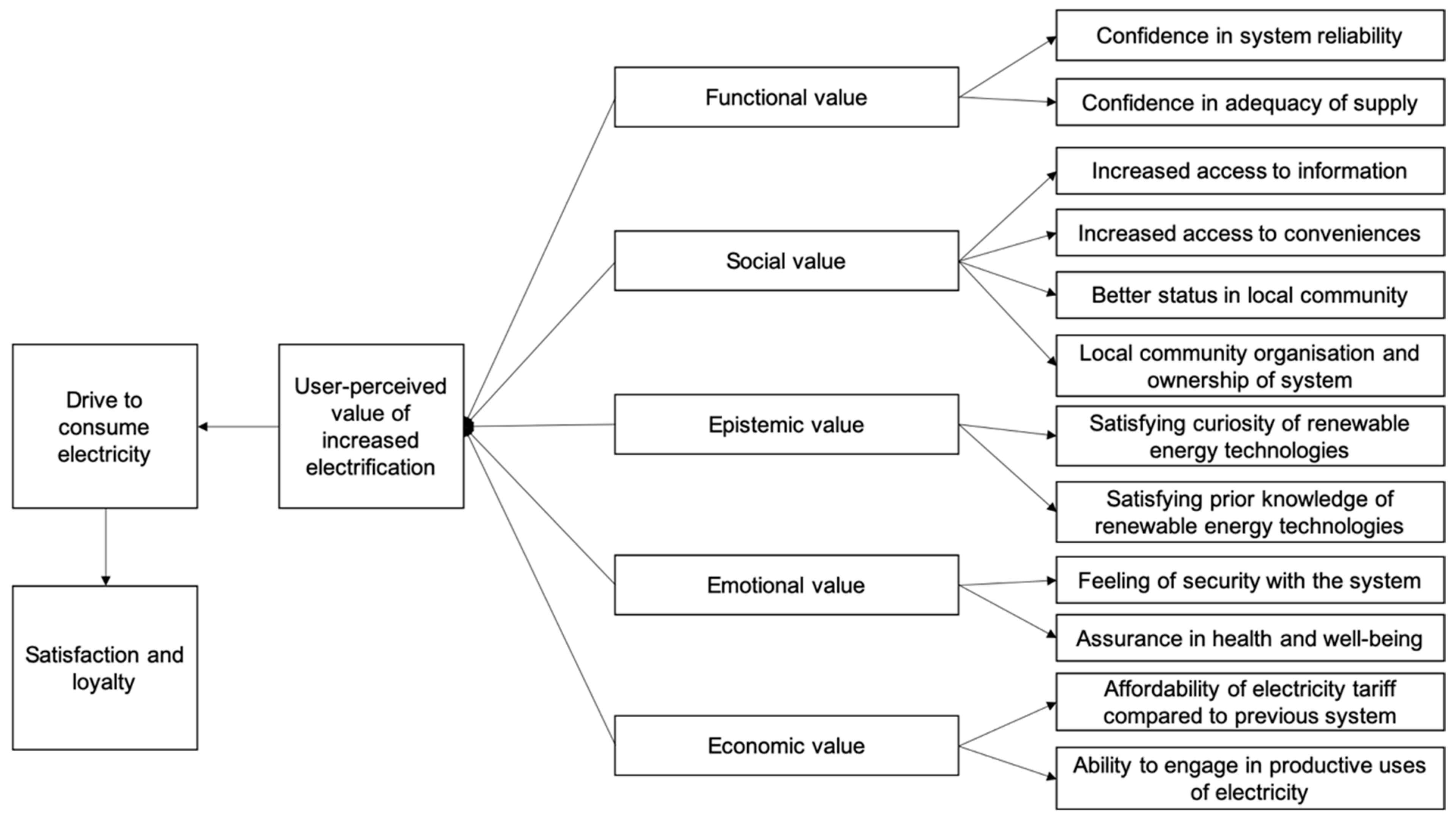
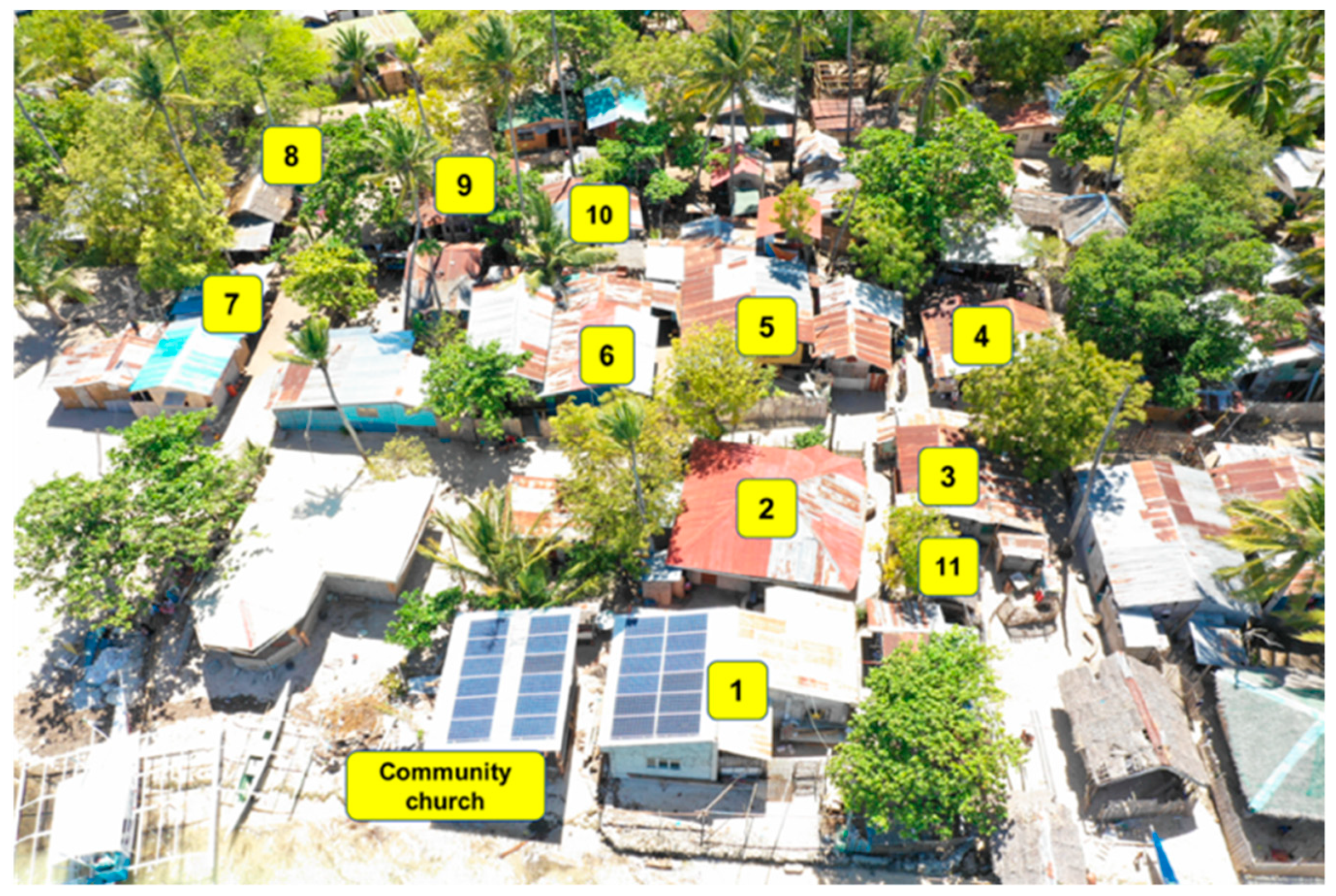
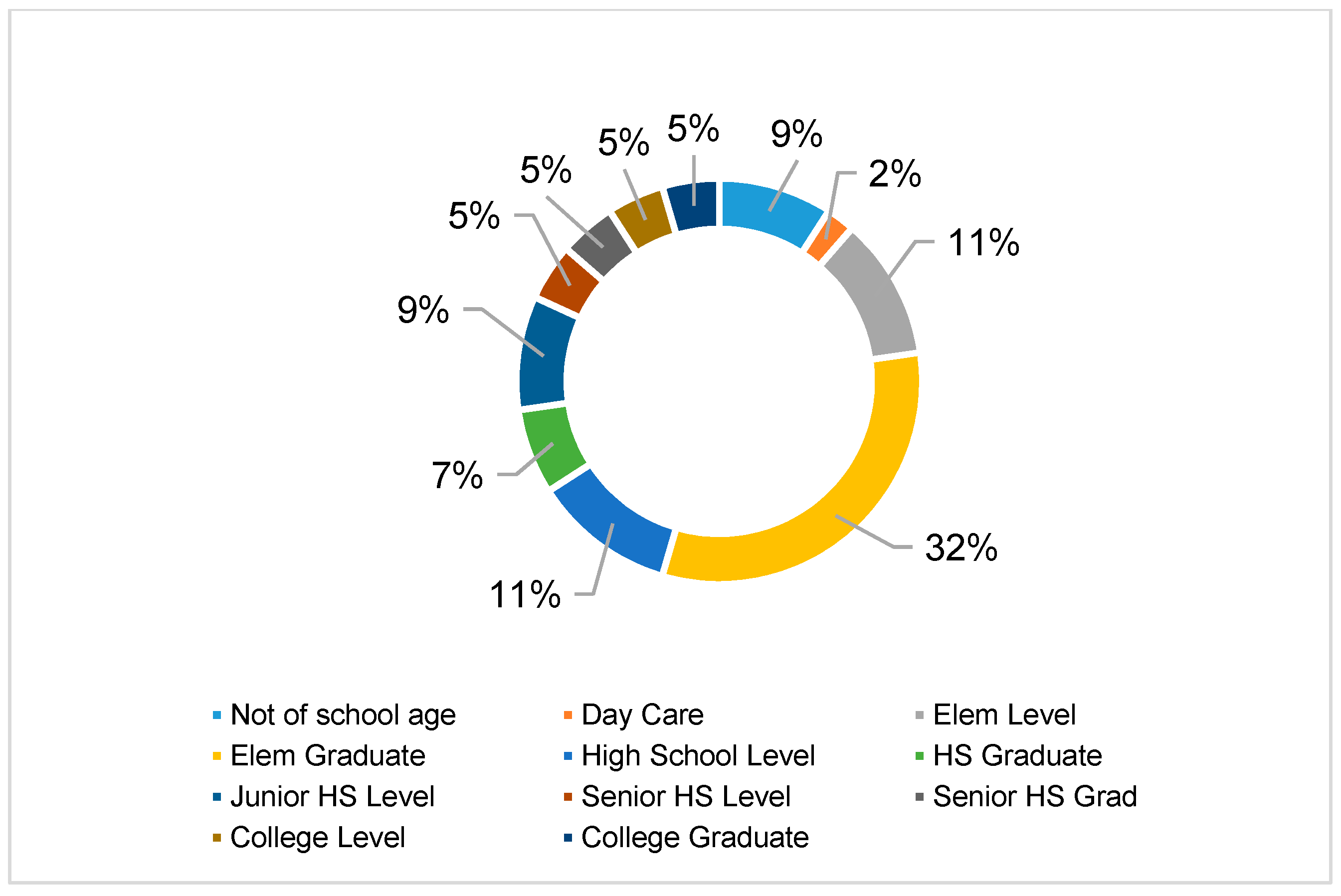
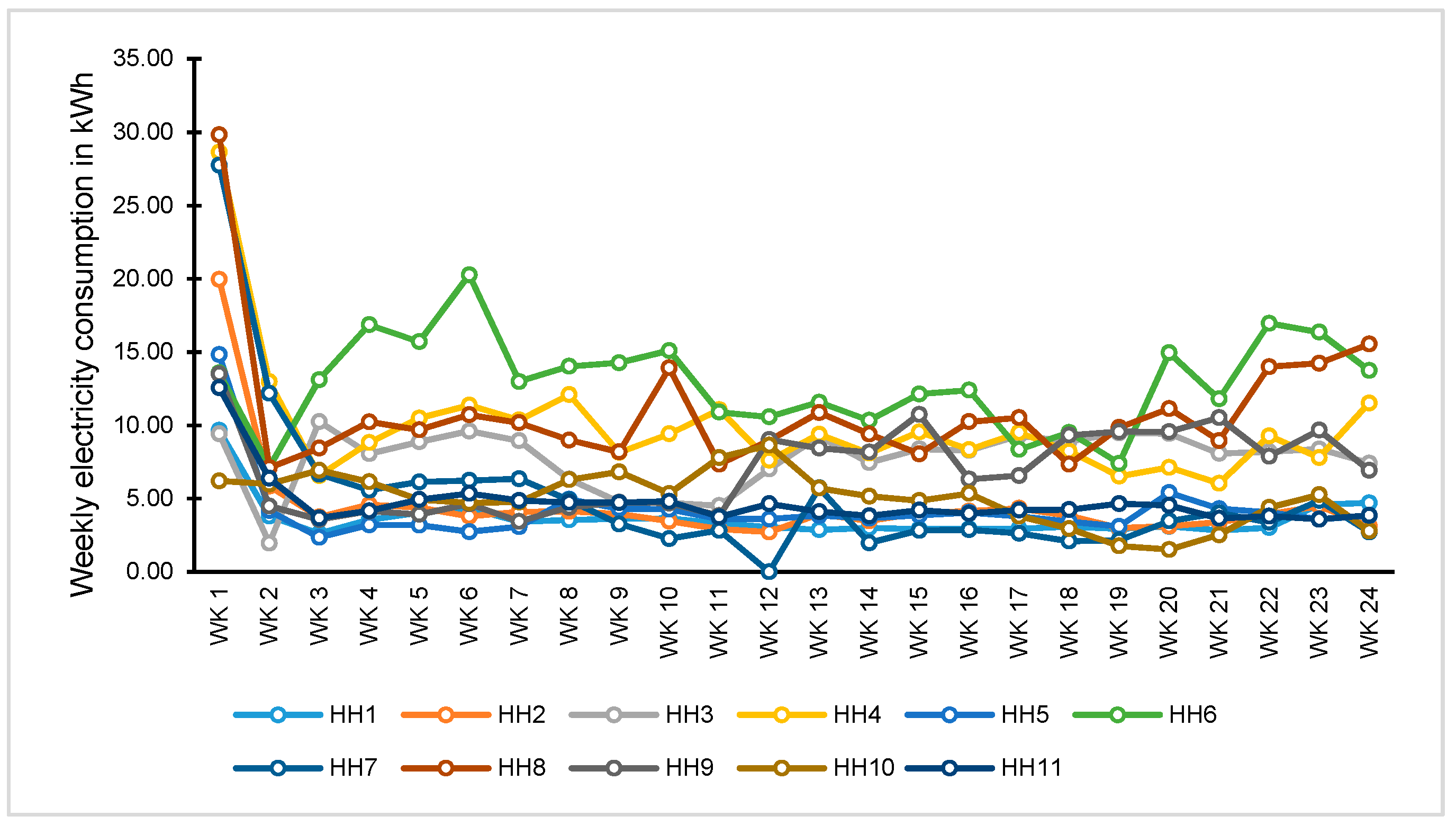
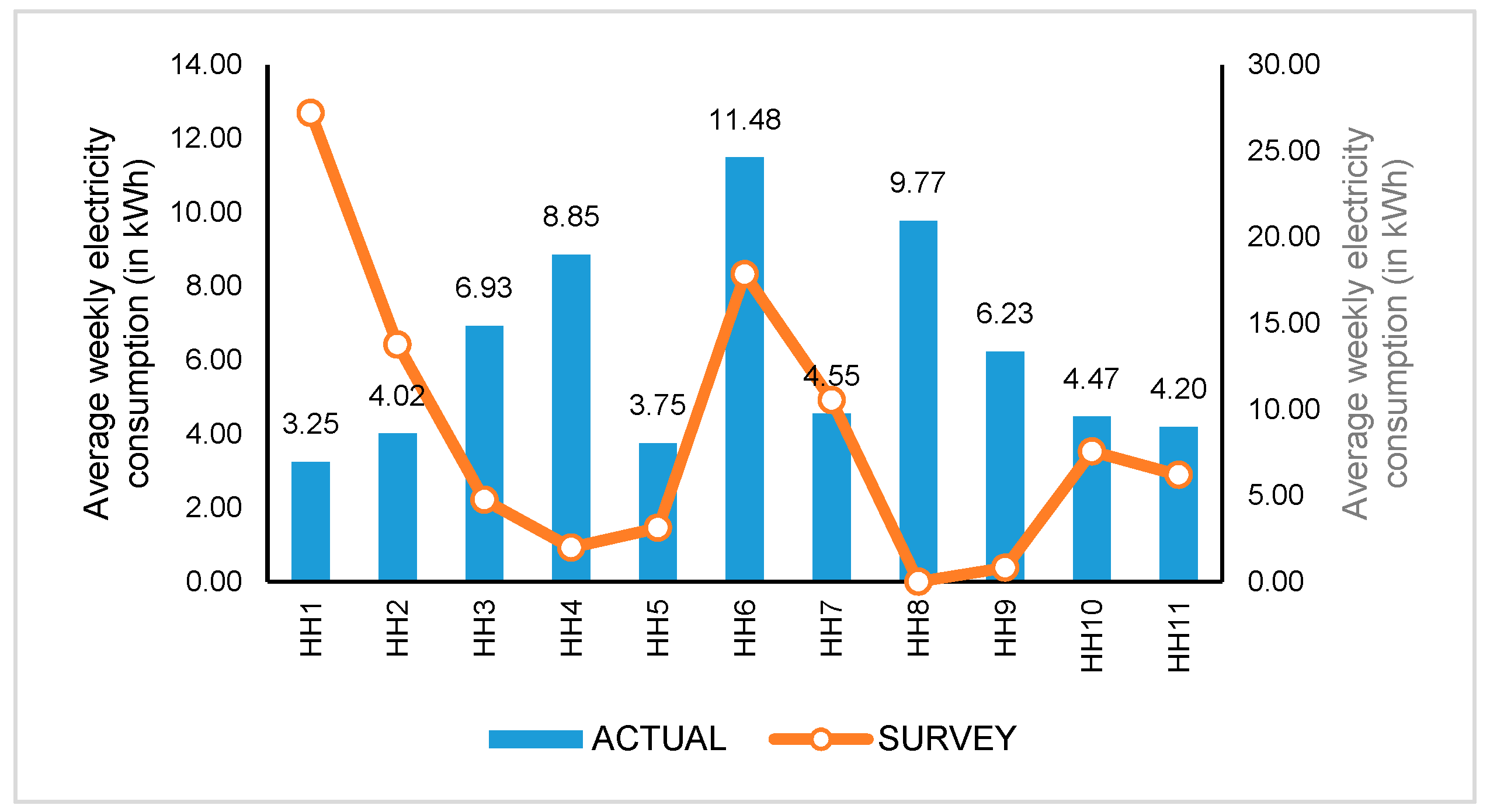
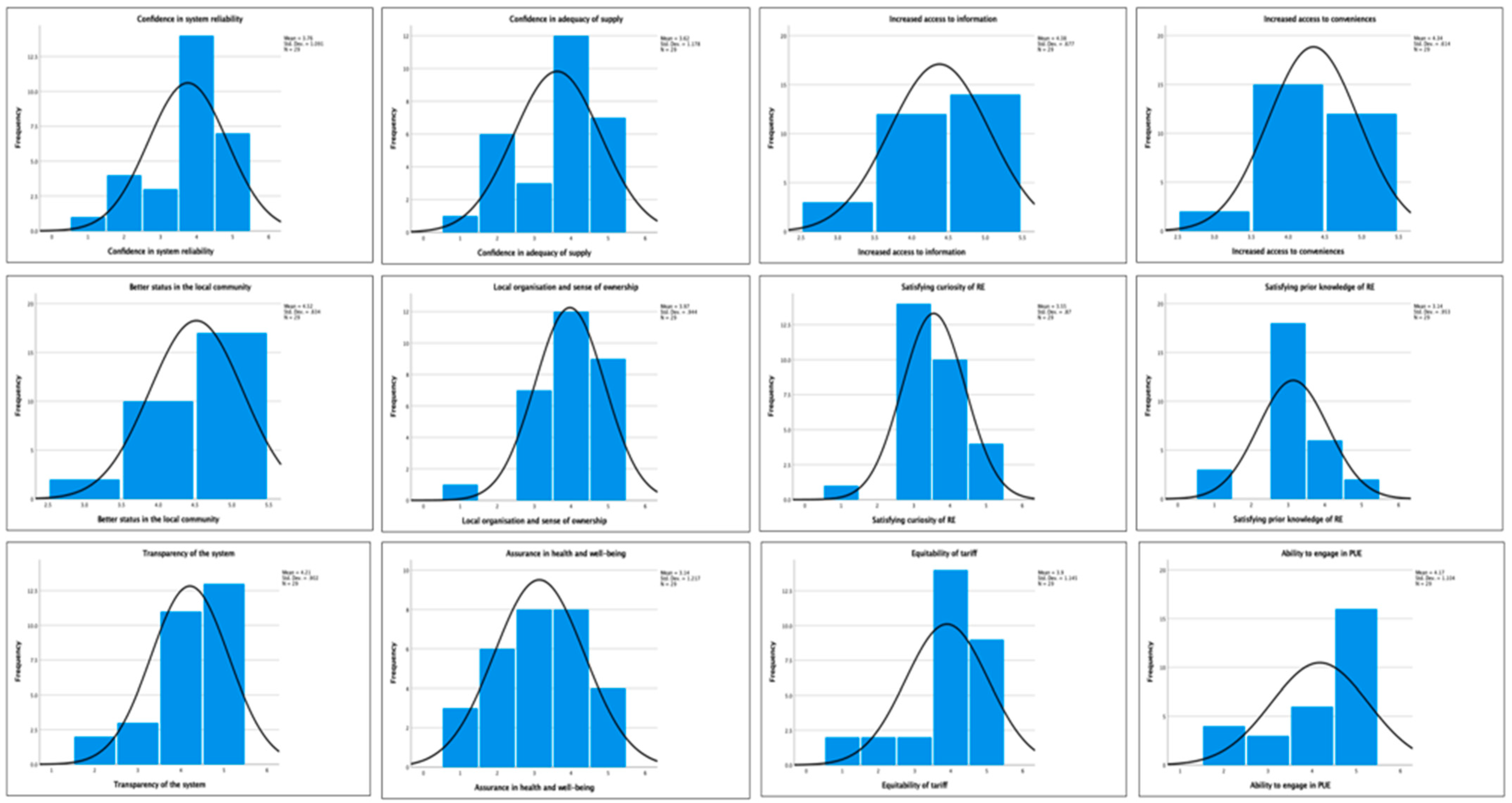
| Driver | Sub-Driver | References |
|---|---|---|
| Economy | Affordability of electricity tariff, productive use of electricity (community-level) or local entrepreneurship | [48,51,52,53,54,55] |
| Technology | Reliability of system, eser interface (metering), appropriateness, adequacy of supply, ease of repair | [48,51] |
| Household energy use | Access to information/entertainment/other conveniences, knowledge attainment, business opportunities, togetherness, operational expenditure, local demand | [52,53,55] |
| Community services | Security/comfort/safety, health and wellbeing, business opportunities | [52,53,54,55] |
| Organization | Maintenance (ability to operate without need for specialized staff), ownership, grassroots organising | [51,55] |
| Poverty mitigation | Pro-poor policies | [55] |
| Numerical Value | Income Classification | Educational Attainment |
|---|---|---|
| 1 | Poor | Elementary level |
| 2 | Lower income | Elementary graduate |
| 3 | - | High school level |
| 4 | - | High school graduate |
| 5 | - | College level |
| 6 | - | College graduate |
| Motivator | Mean | Median | Mode | Skewness | Kurtosis |
|---|---|---|---|---|---|
| M1: Confidence in system reliability | 3.76 | 4.00 | 4.00 | −0.901 | 0.210 |
| M2: Confidence in adequacy of supply | 3.62 | 4.00 | 4.00 | −0.593 | −0.713 |
| M3: Increased access to information | 4.38 | 4.00 | 5.00 | −0.641 | −0.570 |
| M4: Increased access to conveniences | 4.34 | 4.00 | 4.00 | −0.349 | −0.566 |
| M5: Better status in the local community | 4.52 | 5.00 | 5.00 | −0.974 | 0.010 |
| M6: Local organization/ownership | 3.97 | 4.00 | 4.00 | −1.201 | 1.868 |
| M7: Satisfying curiosity of RE | 3.55 | 3.00 | 3.00 | −0.345 | 1.425 |
| M8: Satisfying prior knowledge of RE | 3.14 | 3.00 | 3.00 | −0.558 | 1.474 |
| M9: Transparency of the system | 4.21 | 4.00 | 5.00 | −1.067 | 0.600 |
| M10: Assurance in health/well-being | 3.14 | 3.00 | 3.00 | −0.154 | −0.821 |
| M11: Equitability of tariff | 3.90 | 4.00 | 4.00 | −1.319 | 1.323 |
| M12: Ability to engage in PUE | 4.17 | 5.00 | 5.00 | −1.049 | −0.305 |
| Motivator | Kolmogorov–Smirnov Test | Shapiro–Wilk Test |
|---|---|---|
| Log-transformed functional value | 0.001 | 0.003 |
| Log-transformed social value | 0.008 | 0.002 |
| Log-transformed epistemic value | 0.001 | 0.001 |
| Log-transformed emotional value | 0.060 | 0.061 |
| Log-transformed economic value | 0.001 | 0.001 |
| Motivator | Coefficient of Correlation | |||||
| Household Monthly Income | Respondent Educational Attainment | |||||
| M9: Transparency of the system | 0.095 | −0.272 | ||||
| M10: Assurance in health/well-being | 0.133 | −0.055 | ||||
| Motivator | Estimated Coefficient of Determination | |||||
| Household Monthly Income | Respondent Educational Attainment | |||||
| Cox and Snell | Nagelkerke | McFadden | Cox and Snell | Nagelkerke | McFadden | |
| M1: Confidence in system reliability | 0.024 | 0.026 | 0.009 | 0.104 | 0.112 | 0.041 |
| M2: Confidence in adequacy of supply | 0.020 | 0.022 | 0.007 | 0.210 | 0.224 | 0.085 |
| M3: Increased access to information | 0.031 | 0.037 | 0.017 | 0.223 | 0.262 | 0.133 |
| M4: Increased access to conveniences | 0.074 | 0.089 | 0.043 | 0.296 | 0.356 | 0.197 |
| M5: Better status in the local community | 0.051 | 0.063 | 0.031 | 0.186 | 0.226 | 0.119 |
| M6: Local organization/ownership | 0.051 | 0.057 | 0.022 | 0.174 | 0.192 | 0.081 |
| M7: Satisfying curiosity of RE | 0.009 | 0.010 | 0.004 | 0.170 | 0.190 | 0.081 |
| M8: Satisfying prior knowledge of RE | 0.004 | 0.004 | 0.001 | 0.220 | 0.230 | 0.080 |
| M11: Equitability of tariff | 0.022 | 0.023 | 0.009 | 0.201 | 0.218 | 0.088 |
| M12: Ability to engage in PUE | 0.024 | 0.027 | 0.010 | 0.208 | 0.231 | 0.100 |
Publisher’s Note: MDPI stays neutral with regard to jurisdictional claims in published maps and institutional affiliations. |
© 2021 by the authors. Licensee MDPI, Basel, Switzerland. This article is an open access article distributed under the terms and conditions of the Creative Commons Attribution (CC BY) license (https://creativecommons.org/licenses/by/4.0/).
Share and Cite
Lozano, L.; Taboada, E. Applying User-Perceived Value to Determine Motivators of Electricity Use in a Solar Photovoltaic Implementation in a Philippine Island. Sustainability 2021, 13, 8043. https://doi.org/10.3390/su13148043
Lozano L, Taboada E. Applying User-Perceived Value to Determine Motivators of Electricity Use in a Solar Photovoltaic Implementation in a Philippine Island. Sustainability. 2021; 13(14):8043. https://doi.org/10.3390/su13148043
Chicago/Turabian StyleLozano, Lorafe, and Evelyn Taboada. 2021. "Applying User-Perceived Value to Determine Motivators of Electricity Use in a Solar Photovoltaic Implementation in a Philippine Island" Sustainability 13, no. 14: 8043. https://doi.org/10.3390/su13148043
APA StyleLozano, L., & Taboada, E. (2021). Applying User-Perceived Value to Determine Motivators of Electricity Use in a Solar Photovoltaic Implementation in a Philippine Island. Sustainability, 13(14), 8043. https://doi.org/10.3390/su13148043






